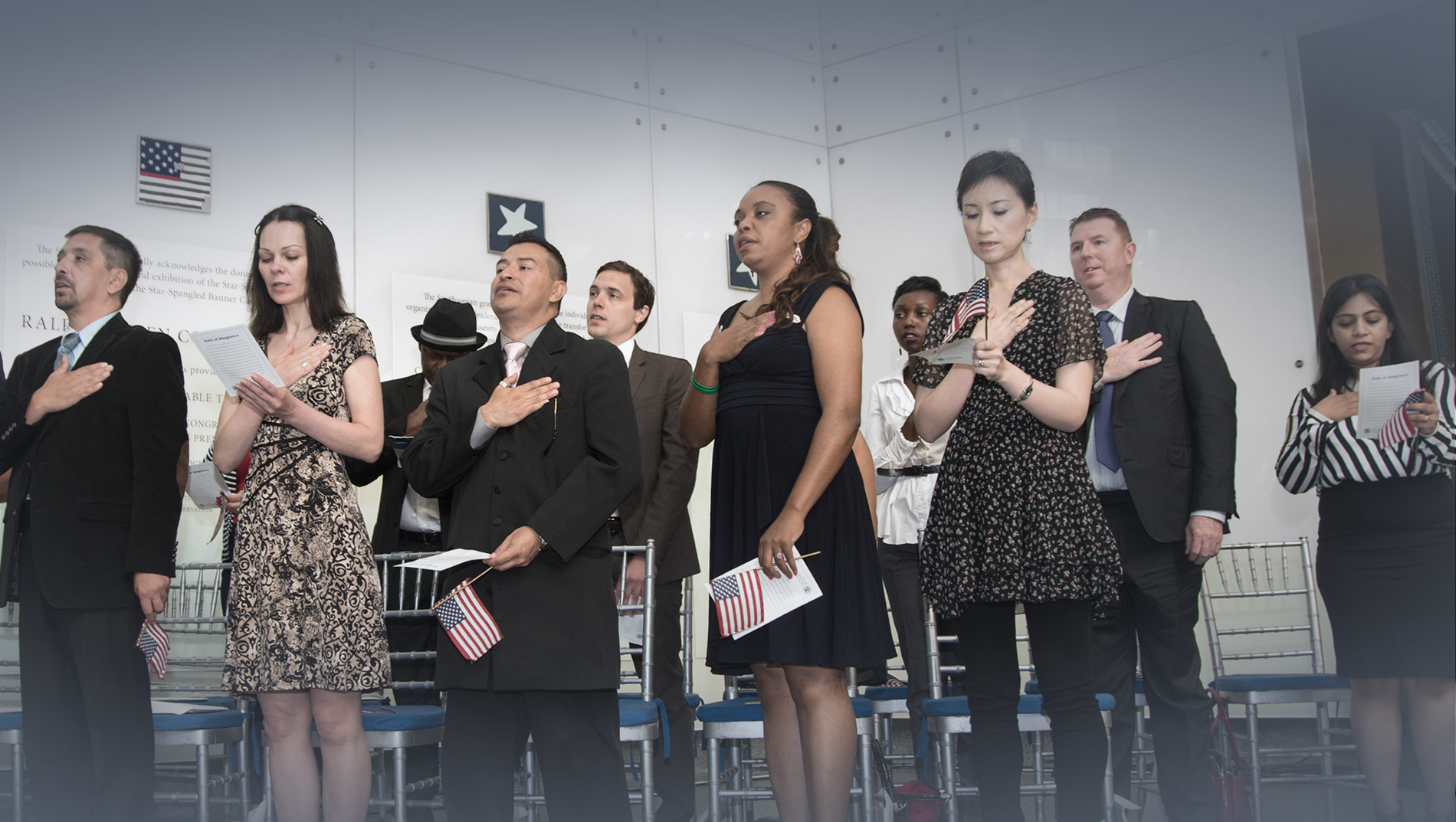Immigration 101
How the United States Immigration System Works
- How the Immigration System Works
- June 24, 2024
U.S. immigration law is very complex, and there is much confusion as to how it works. This fact sheet provides basic information…
Read More
Birthright Citizenship in the United States
- Birthright Citizenship
- October 16, 2024
This fact sheet explains birthright citizenship, the Fourteenth Amendment, and its interpretations. Who is…
Read More
Asylum in the United States
- Asylum
- August 27, 2014
Asylum seekers must navigate a difficult and complex process that can involve multiple government…
Read More
The Three- and Ten-Year Bars
This Fact Sheet provides background on the three- and ten-year bars and waivers, and explains the recent regulatory changes. Read More

Second Annual DHS Progress Report
In its second year under the Obama Administration, the Department of Homeland Security (DHS)—which is responsible for the nation’s three immigration agencies (USCIS, CBP, and ICE)—continues to struggle with its competing missions of providing immigration benefits and enforcing immigration laws, all within the context of an outdated and broken immigration system. Over the past year, while waiting for Congress to act, the Administration has increased its emphasis on enforcement and deportation and denied its ability to provide administrative relief. This report finds that, while DHS has made significant progress in some areas, there is much room for improvement. The report recommends that DHS act in line with its own stated priorities and exert its executive authority to bring about much-needed reforms that can be done in the absence of Congressional action. Read More

The Diversity Immigrant Visa Program: An Overview
This fact sheet provides an overview of the diversity visa program, the requirements and security checks currently in place, and demographic information about recipients. Read More

Constitutional Citizenship: A Legislative History
Attacks against the Citizenship Clause of the 14th Amendment have picked up in recent months, with legislators at both the national and state levels introducing bills that would deny U.S. citizenship or “state citizenship” to the children born to unauthorized immigrants in the U.S. There are two strands of attacks on birthright citizenship. One strand arises out of simple nativist anger at the impact of immigrants, legal or otherwise, on society. The other argues that the current interpretation of the Citizenship Clause as covering the children of “illegal” immigrants is inconsistent with the “original intent” of the Framers of the 14th Amendment. Originalism is often used as a method to clarify unclear portions of constitutional text or to fill contextual gaps in the document. This is not, however, how originalism is being used in the context to the Citizenship Clause. Here, originalists use clever arguments and partial quotations to eradicate the actual text of the Amendment. In essence, they claim the Framers did not really mean what they said. Read More

Papers Please: Eliminating Birthright Citizenship Would Affect Everyone
Attacks on birthright citizenship at the federal and state level are bound to take many forms—from outright repeal of the Fourteenth Amendment to refusal by states to issue birth certificates to children of undocumented immigrants. Whatever the tactic, attacks on birthright citizenship hurt everyone. Read More

The New American Electorate (October 2010)
At a time when federal, state, and local elections are often decided by small voting margins—with candidates frequently locked in ferocious competition for the ballots of those “voting blocs” that might turn the electoral tide in their favor—one large and growing bloc of voters has been consistently overlooked and politically underestimated: New Americans. This group of voters and potential voters includes not only immigrants who have become U.S. citizens (Naturalized Americans), but also the U.S.-born children of immigrants who were raised during the current era of large-scale immigration from Latin America and Asia which began in 1965 (the Post-1965 Children of Immigrants). Read More

The Unwanted: Immigration and Nativism in America
It’s hardly news that the complaints of our latter-day nativists and immigration restrictionists—from Sam Huntington to Rush Limbaugh, from FAIR to V-DARE—resonate with the nativist arguments of some three centuries of American history. Often, as most of us should know, the immigrants who were demeaned by one generation were the parents and grandparents of the successes of the next generation. Perhaps, not paradoxically, many of them, or their children and grandchildren, later joined those who attacked and disparaged the next arrivals, or would-be arrivals, with the same vehemence that had been leveled against them or their forebears. Similarly, the sweeps and detentions of immigrants during the early decades of the last century were not terribly different from the heavy-handed federal, state, and local raids of recent years to round up, deport, and occasionally imprison illegal immigrants, and sometimes legal residents and U.S. citizens along with them. But it’s also well to remember that nativism, xenophobia, and racism are hardly uniquely American phenomena. What makes them significant in America is that they run counter to the nation’s founding ideals. At least since the enshrinement of Enlightenment ideas of equality and inclusiveness in the founding documents of the new nation, to be a nativist in this country was to be in conflict with its fundamental tenets. Read More

Explaining the Recent Decline in Unauthorized Migration
Immigration Enforcement in a Time of Recession Recent estimates from the Pew Hispanic Center indicate that the number of unauthorized immigrants in the United States has declined by roughly one million since 2007—bringing the total size of the unauthorized population to approximately 11.1 million. Coming after the release of similar estimates by the Department of Homeland Security (DHS) in January, these figures have provoked considerable speculation as to how much of the decline is attributable to the current recession, and how much is the result of heightened immigration enforcement. DHS, for instance, was quick to take credit for the drop, citing the money and manpower that have been poured into immigration enforcement by the Obama administration. However, immigration researchers were just as quick to point out that unauthorized immigration has always responded to the state of the U.S. economy, and that the downward trend captured by both Pew and DHS matches up closely with the beginning of the recession in December 2007. Read More

Back to the Border: A Historical Comparison of U.S. Border Politics
By Katherine Benton-Cohen and Geraldo Cadava During the spring and summer of 2010, America’s broken immigration system erupted into national news headlines as a result of the passage in Arizona of a sweeping anti-immigrant law (SB 1070), growing concerns over drug-related violence along the U.S.-Mexico border, and calls in some quarters for a repeal of the Fourteenth Amendment’s guarantee of birthright citizenship. While these events might seem new, the issues involved—unauthorized migration, labor disputes, violence, federalism, and constitutional rights—have played out over and over again, particularly along the border. Back to the Border provides analyses by two historians who situate today’s controversies within the context of the broader history of the border region. Understanding that history not only allows us to make sense of the complex issues behind the current rhetoric, but also demonstrates why it is necessary to go beyond the rhetoric and search for lasting solutions. The following “Perspectives” by historians Katherine Benton-Cohen and Geraldo Cadava compare and contrast conditions and incidents along the Arizona border in 1917, 1976, and 2010. The similarities between the three eras are startling. Read More

Immigrants in the U.S. Labor Force
New CBO Report Underscores Diverse Contributions of Foreign-Born Workers A recent report from the Congressional Budget Office (CBO) underscores not only the diversity of the foreign-born labor force in the United States, but also the myriad roles that immigrant workers play in the U.S. economy. The report, which analyzes data from the Current Population Survey, finds that 15.5 percent of the U.S. labor force was foreign-born in 2009, up slightly from 14.5 percent in 2004. Moreover, immigrant workers and their native-born counterparts differ significantly in terms of occupation and education, as well as where in the country they live. As other, more detailed analyses have confirmed, this suggests that immigrants and natives are filling different niches in the U.S. labor market and are therefore not in direct competition with each other for most jobs. Read More
Make a contribution
Make a direct impact on the lives of immigrants.

